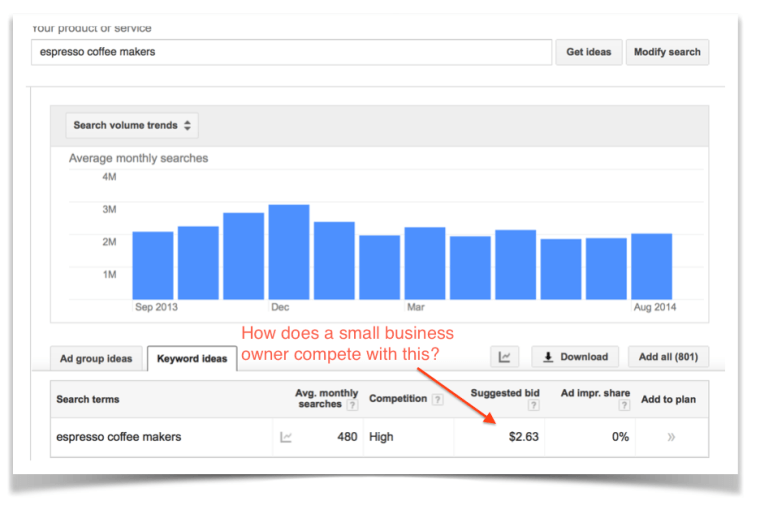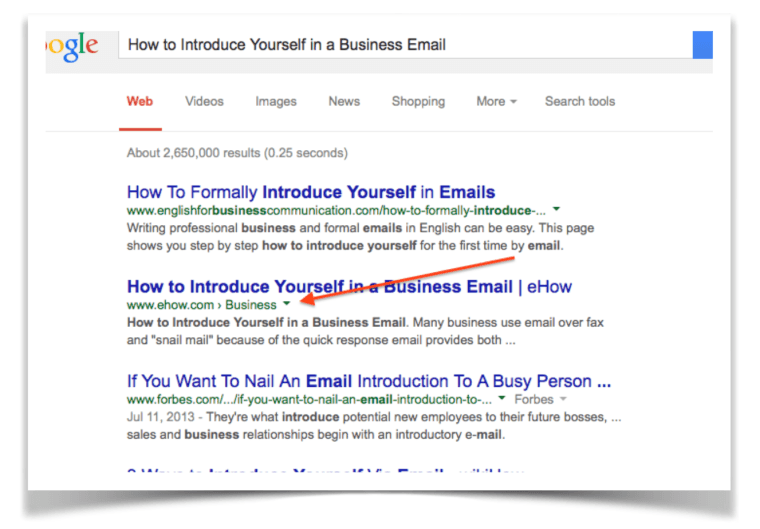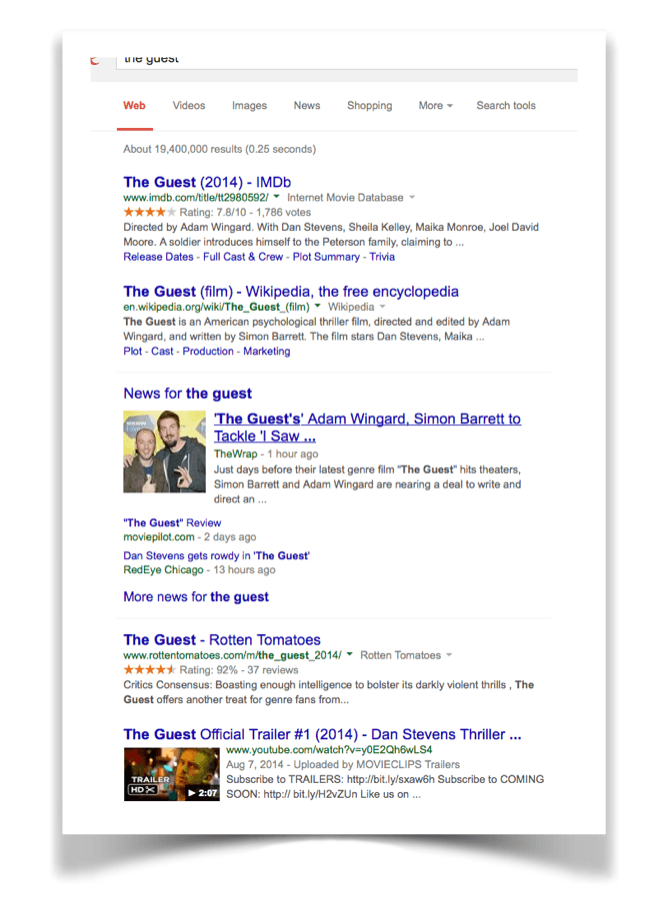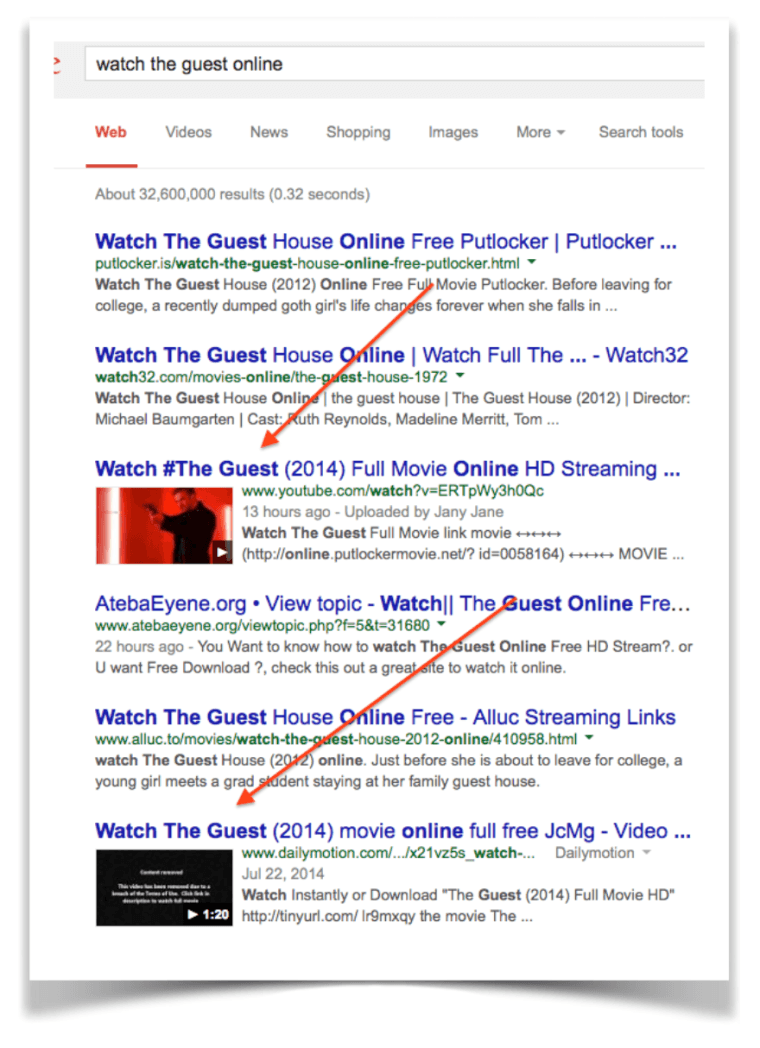Google conspiracy theories aren’t new. Everyone likes to believe their rankings have tanked thanks to something other than poor-quality content or bad linking practices. In reality, a lot of people are guilty of less-than-great SEO. At the same time, it’s hard to ignore the fact that some businesses, no matter how “white hat” their methods, can never seem to gain traction in the SERPs.
If you’re having trouble getting the traffic you want, it might just be conspiracy fact.
A Small Business Problem: The Adwords Platform Isn’t Very Friendly
One of the first nuggets of marketing advice you’re given, as a small business owner, is to market online using Google Adwords. It’s supposed to be a relatively predictable, and affordable, method for generating new leads.
But, that train left the station years ago. Google Adwords is expensive, and it’s mostly where large corporations (or super-savvy and experienced marketers) play around with ad dollars. Large brands helped create those high prices through bidding wars. Many large companies just want to be “on top,” and are willing to drive the price of keywords through the roof.
This is a problem if you’re a small business owner. Why? Because you simply can’t afford to compete. In 2012, for example, the average cost per click for keywords sat at $0.84. Think about that for a moment.
This means that small business owners spend almost a dollar for a click. You need at least 1,000 leads for to make the venture worthwhile and to prove an ad. In other words, you need to spend $840, on average, just to test a marketing idea. If it fails, and many of them do, you start over, complete with another $840 ad spend.
And this is an average. Some industries are far more expensive, with insurance keywords ranging from $5 to over $10. Of course, some industries are less expensive, but the $0.01-per-click days are over.
 Screenshot of AdWords Keyword Planner
Screenshot of AdWords Keyword PlannerTo achieve a 1 to 3 percent conversion rate, typical for direct marketing, you need at least 1,000 leads per month, probably more. Even then, you’re only talking about 10 to 30 leads. Unless you have a high-ticket item, you’re spinning your wheels at such a low volume.
You’ll need tens of thousands of leads, and that becomes expensive for most retailers who generally use keystone pricing (a 50 percent markup) for their goods. At the end of the day, small businesses may find their ad budget could swell to well over $10,000 a month – far too high for the small entrepreneur.
And, the cost for conversion is estimated to be about $24.50. That means, a customer costs $24.50, on average, with some industries higher, and some lower. Unless you’re selling bigger-ticket items, you simply cannot compete.
But, is that Google’s problem?
They’ve created a platform that’s more suitable for companies who can afford to brand, yet Google often markets itself as a sort of online classified-style ad service. There’s the disconnect. Businesses believe they’re able to pay for leads in a cost-efficient manner. In reality, it’s become a very expensive way to generate leads. So, while it’s not Google’s fault that the platform has become what it is, it’s also not fair to say that this is a platform that’s suitable for inexperienced small businesses and entrepreneurs – because it’s not.
The Organic SEO Problem: Are Honest Businesses Being Outcompeted By Spammers?
The high cost of buying leads often turns businesses’ attention towards organic SEO. But, many businesses soon find out that this is no walk in the park either. It’s really, really, difficult to create so-called “killer content” that ranks well on its own and brings in paying traffic.
So, some people turn to the “dark side” of search marketing – “black hat marketing”. It’s against Google’s TOS, but that doesn’t stop many businesses from trying to game the system. For some, results come quickly, and it’s hard to argue with money in the till. At the same time, there’s that little voice in the back of your head that’s telling you, “This is wrong. You’re going to get caught, and your website is going to be toast!”
Really, Google expects you to pump out great content, and then let them do the ranking for you. If you try to manipulate or influence your rank in any way, that’s considered “cheating” and Google penalizes you for it – or do they?
There’s some evidence that this doesn’t really happen, or at least not consistently. Take the case of adipexcart.com. It’s a website that’s baffled some SEOs for years. Why? Because it continually evaded and avoided Google’s algorithms using subdomains.
The site is (or was, it’s so hard to tell now) an affiliate site that sold Adipex-P (Phentermine), a weight loss drug. It didn’t really have anything going for it except that its subdomain pages ranked very well for target keywords. All of those keywords (links), however, were held in the root domain and the site itself forwarded to the subdomain that ranked in Google.
When Google updated its algorithm, or it “passed through” its filters, one of its sub-domains received a penalty, but the domain itself wasn’t affected (for whatever reason). The end result was that the subdomain was roasted but the site owner set up a new one and, in a few days, he was back in business, so to speak.
This has led some to believe that Google occasionally gives a “pass” to some sites or industries or *gasp* doesn’t really have a good handle on spam sites at all. Other examples of wonky rankings include:
eHow
Probably the most famous case of black-hat-turned-gray is Demand Media. Demand Media is the owner of the infamous “how to” content farm “informational site,” eHow. But, in the wake of Panda 2.0, it took a massive 60+ percent hit, losing ranking and traffic for a lot of its keywords. It should be erased from the Internet by now. Where is it? Why, it’s back on top again outranking irrelevant, no-name sites like Forbes.com for important business-related topics no less.
From one of its articles on business:
 Screenshot of Google Search for “How to introduce yourself in a business email”
Screenshot of Google Search for “How to introduce yourself in a business email”You can see that its title “How to Introduce Yourself in a Business Email” ranks #2. What’s the value of this keyword? It’s hard to say, now with social media and personal preferences affecting rank, but if you log out of your Google account, specify a generic location like “USA,” and then clear your search history, you can see that eHow is still outranking a real authority site like Forbes.
C’mon – Forbes is business. How can eHow be more authoritative than Forbes on this matter? eHow is a generic site with a wide variety of subject matter. The only posts that Forbes puts up are related to business. SEOBook even has a rather long analysis of the insanity that is eHow.
But, it’s not just one page. eHow seems to have recovered (at least somewhat) in the SERPs for many important keywords. So much for quality control.
Google Properties
This one probably gets overlooked a lot because no one really believes that this technique still works. But, it does. Google still favors its own web properties, like Blogger and YouTube, and sometimes ranks them ahead of other sites that might be more relevant. Sometimes, though, Google properties are used for spamming, and “Big G” seems to look the other way.
For example, search for a listing of the newest movies playing in the theaters right now. As of this writing, there is a new movie out called “The Guest.” Let’s see what ranks in Google when we search for it.
“The Guest”:
 Screenshot of Google search for “the guest”
Screenshot of Google search for “the guest”Pretty normal stuff. However, let’s add a modifier to that, “watch the guest online”:
 Screenshot of Google Search for “watch the guest online”
Screenshot of Google Search for “watch the guest online”Now, it doesn’t take a genius to realize that a movie that’s in theaters isn’t going to be online for free. So, who has access to the full movie? It’s either a bootlegger or, more likely, a spammer planting linkbait.
This is how spammers gain entry into the search engines where they don’t belong. You see, if you can get ranked here, you can use that ranking to then boost some other web property you own – or, at least, you can gain the much-needed visibility that your spam site wouldn’t otherwise get.
Another old trick that still seems to work sometimes is rich snippet spam.
This is where the offending site boosts its “star rating” by using some fancy hReview markup code. That’s it. All a spammer has to do is place some code and Google will eat it up – especially if the person is employing a legit tool like Yoast’s SEO plugin for WordPress.
Why does this work? Well, it doesn’t influence the site’s ranking directly, but Google reads the site’s meta-description for cues as to what to put in the SER when the site does appear. Users will see the description of the site, and then see the stars under the descriptions, thanks to the tricky code inserted by the spammer.
This creates false authority, but it’s usually enough to trick users – at least for a while. If enough users are tricked by the site, then it becomes an actual authority site capable of outranking a real authority site.
To be fair, Google has done a few things to curb this practice, including manual reviews.
But, probably one of the more devious methods still persists today, and that is the 301 redirect.
Let’s say you want to spam the search engines. You could set up a Blogger blog or something on OverBlog. Those are both legit sites. In fact, Google still loves Blogger – you could set up your “legit” site there that redirects to your spam site. Don’t even try to rank the spam site, but worry about the legit site. If the spam site gets roasted by Google, it’s no big deal. Just use 301 redirects to a new site and you’re back in business.
This is how some spam sites seem to keep outranking true authority sites. Of course, the “white hat model” will eventually beat them out, unless they can keep up the redirects. Then, it becomes a game of cat and mouse.
Citadel-Insurance.co.uk
The now-famous spam site, Citadel-Insurance.co.uk, came out of nowhere to steal (quite literally) the number one spot away from its competitors. How did it do this? When the website was set up, it was nothing if ordinary. It didn’t really even have any content. Solution: steal backlinks. No, really. Someone hacked into real, legit, websites and planted real, “legit,” backlinks to the spam site. Using this technique, it was able to build a massive backlink profile that any real company would be jealous of. It looked “natural” because the links pointing to the spam site were inserted into content and other places where meritorious links would ordinarily go.
Then, the Citadel site made a huge mistake by going after a super competitive term, “car insurance.” Had it gone for other, lesser, keywords, it might have actually gotten away with it.
But, this teaches other spammers a lesson. You can still do this trick and get away with it if you’re careful. Yes, it involved breaking the law, as well as Google’s TOS, but it’s possible. And, that’s not the scary part. If a spammer is really good at it, he may never be caught because it doesn’t leave a footprint.
On a positive note, this teaches everyone else a valuable lesson about SEO. It appears that link velocity is significant and can overcome a lot of other “iffy” link signals (e.g. coming out of nowhere to rise to the #1 spot for a competitive search term).
Private Link Networks
If you’re using something like the late, great, BuildMyRank (click here for a history of BuildMyRank, in case you’re not familiar with it), you’re not going to get very far. However, if you’re buying and building your own blog network, you will survive. And, if you’re smart about it, you’ll survive for a long while. You might even beat out your competitors who have worked their butts off doing things the “white hat way”.
Of course, if you have the money, al la Kickstarter or Indiegogo, you could also just buy out famous or semi-famous bloggers and make them link to you – absorb them, and literally make them part of your business. That’s a strategy that’s not necessarily blackhat, but it can easily be abused and used by spammers.
Buying Backlinks From SEO Agencies and Link Spamming
This has always been on Google’s “no-no” list, but some agencies and bloggers still get away with it. Firms are getting more clever about the practice though. For example, so sites will set you up with an article for your blog that looks legit with at least two or three different links embedded right in the content. To sweeten the deal, they’ll offer you money – and that’s where things get hairy.
If agencies offer money as a “thank you” instead of calling it a “paid link” does that count as a paid link? If you’re in the camp that thinks it does, then you’d probably write to Google and complain about it. But, at the same time, this is how some otherwise legitimate sites, big brand names even, get away with buying links.
And, as long as you’re buying links, why not engage in a little link spamming? This is something you would think Google had put a lid on, but it hasn’t. It only says it has.
You could use agencies that sell blog posts to legit sites to help you with this. Just pay for a few backlinks through one of these agencies (for legitimacy) and do the appropriate 301 redirects on your site, as needed. It would look something like this:
Paid Links from Legit Sites > Spam Site > Redirects From Spam Site To “Money Site”
Or, you could go it alone, like Makemoneyninja did. This webmaster has an interesting case study about how they successfully used link spam post-Panda and Penguin to make decent rankings in the SERPs and funnel money into their bank account.
A Spam Control Problem: Transition Rank + The Social Bubble
Even if we look beyond the spam sites, and Google’s inability to control them all, we’re left with the cruel consequences of social media and what Google is calling “transition rank” – both of which make it nearly impossible to really get a handle on where we rank in the grand scheme of things. It’s humbling.
Google has invented a new way of shuffling us all over the place in its SER, and it’s called “transition rank.” Transition rank is a way for Google to hide how it’s ranking you in by moving you around in a somewhat haphazard way without sending you any signals as to why it’s changing your rank.
It’s also taking a hardline stance against traditional linkbuilding. Basically, anything you do to manipulate your search engine ranking can be considered spam. That includes going out and doing white hat linking. Wait. What?
Yep, Google is putting the kibosh on all this white hat/black hat stuff and just calling it all “spam”. This shouldn’t be a surprise. Google has hinted in the past that it wanted to be the final authority on ranking, and that it wanted everyone to stop trying to analyze its algorithm.
Basically, transition rank is the “invisible hand” of Google that allows the company to move you around without telegraphing that move. Its patent, called “Ranking Documents” involves a system that will create two ranks associated with a piece of content, which they call a “document”.
The content will move between the first and second rank without any change in ranking factors associated with that content. In other words, even when your content looks like it should be ranking well, it might not be. And, if it looks like it should be ranking well, and it is ranking well, it doesn’t mean that it will stay there.
In fact, Google may just be figuring out whether to drop the axe on your page. This allows Google to move your ranking around in an apparently random manner without giving you any signals as to where you will end up. It also allows the company to shuffle you around before deciding where you belong.
The real kicker is that this transition rank is incredibly smart. It pays attention to your reaction to any changes in rank. If it detects behavior consistent with a spammer, it will know what to do with your page.
There’s also a problem of The Social Bubble. This is a phenomenon that’s sprung up in recent years due to the growing popularity of social media sites. When you log into Google, you’re connected to your Google+ account. Remember when Google made a big deal about modifying your search results based on past search behavior, friends’ search results, and other factors? Well, it’s been silently collecting data on you in an attempt to come up with what it thinks you want. We see this today in default search settings. For example, Google knows where you’re searching from, and displays results based on your location, by default. That’s just one way Google personalizes search results.
And, regardless of whether you think it’s a good direction for search to move in, the fact remains that it alters search results, sometimes in a dramatic way.
Eli Pariser has spoken a lot about this issue. It adds an impossibly complex variable to the SEO equation. You see, you can’t control how people search the web, who their friends are, and whether or not they search the web while logged into Google. And yet, if you’re not in someone’s social circle, you may not appear in their search results.
You also can’t tell if users regularly clear their search history and change their default location (hint: most people don’t). All this to say that everyone’s search results will look different. There is no more “universal search result.” There’s only individualized results now. Most SEOs have missed this one, and carried on as though they were operating in a pre-social media web (despite their lip-service to its importance in search).
Solution: Identify The Real Problem
Let’s say you’ve noticed a drop in traffic. You check search terms for keywords you should be ranking for, but are not. Or, let’s say you’re ranking for them, but you notice a spammer outranking you.
Stop. Make sure that the site outranking you is actually webspam. Sometimes, competitors will set up elaborate negative SEO campaigns to try to damage their competition. This may positively affect their search rank temporarily under Google’s new transition rank scheme. So, what you might be seeing is a temporary bump.
You may also be seeing a permanent placement, but not due to the linkspam. Some companies use a combination of spam links and legit links, and it’s the strength of the legit links that keeps it cemented to the first page. The linkspam is just to throw you off the scent so you can’t reverse engineer their link strategy (or, at the very least, it’s super-duper difficult to do).
Finally, if you know that you’re being outranked by a spammer, the simple solution is to report them. Citadel-Insurance.co.uk didn’t last long after it was reported.
If you suspect that you’re being treated unfairly, re-examine your link strategy. Are you being caught in transition rank? Maybe the shuffle is temporary. Maybe Google is trying to figure out where you should be by focusing on your reaction to your site’s change.
Solution: Use A Better SEO Strategy
Maybe you just need a better linkbuilding strategy – one that helps you build links without direct concern for SE rank. In other words, don’t worry so much about whether a link will help you rank, and instead focus on the value of that link, and whether it will earn you clickthrough traffic – you remember clickthrough traffic, right?
One way forward is to focus intensively on the quality of the content you’re producing, al la Brian Dean. His skyscraper technique is a bit unorthodox, but it’s been instrumental in getting him the kind of traffic that most webmasters only dream of. The downside? It requires effort – a lot of effort. It requires so much effort that 99.9 percent of webmasters simply won’t do it. It’s that hard.
That’s good news for you, because you can take advantage of that and scoop up some traffic, reducing your reliance on an outside SEO firm to improve your ranking for you.
Another strategy is to focus more of your attention on making friends on Google+, widening your social circle, and spreading your business via other channels that have nothing to do with Google.
For example, get yourself known on LinkedIn, on Google+, on Facebook, and maybe even Twitter. These aren’t great advertising avenues, mind you, but they are great ways to get to know people and participate in discussions and events that you ordinarily wouldn’t participate in. And, the more interaction you have with people, the more likely you are to appear not just in their social networking feeds, but in their search results.
This strategy is usually something people do in desperation, fail at it, and then wonder why it didn’t work. They curse the SEO who recommends it, and then go back to their old ways.
The real trick to making social media work is the effort. A lot of effort. Do you see a repeating theme here?
When you make connections on Facebook, for example, it helps to make friends with them. Choose high-value people and get to know them. Show a genuine interest in them. Message them and chat with them. Share their posts. Occasionally, they will share your posts. This is how you gain influence – stay focused when you post on your own wall. Don’t worry about posting to your business FB page. Post to your personal page and post often about your interests and your business or industry.
If you choose to stick it out with Google, realize that, at the end of the day, Google holds all the cards. You’re playing on its platform and by its rules. You can only adhere to best practices, observe, report “cheaters,” and try to figure out alternative avenues for bringing traffic to your site.
What do you think? Have you been a victim of webspam or are you really just caught in a transition-rank-and-social-bubble universe?
Featured Image: Igor Mojzes via Fotolia





